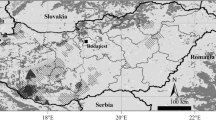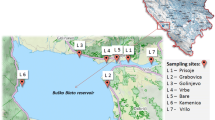Abstract
We clarify the contribution of gene introgression in the recovery of the sable Martes zibellina, which has undergone significant population declines by the end of the nineteenth century. To verify the contribution of interspecific gene introgression, variation among the sable and the pine marten Martes martes was investigated utilizing restriction fragment analysis of the mitochondrial cytochrome b gene as a genetic markers. Evidence of symmetric introgression of mitochondrial genes between the species was detected. Frequency of marten haplotypes in the sable was 8.3%, while sable haplotype was found in 10% of the martens. The low frequency of mitochondrial DNA haplotype A indicates a comparatively low portion of the Eastern lines in the current sable populations in Western Siberia, despite the introduction of a large number of Eastern sable subspecies. These findings are of great importance for the conservation genetics of the sable. Overhunting of the sable as a more fur valuable species than the pine marten may lead to violation of the dynamic equilibrium between genetic systems of these related species. Mitochondrial markers can be used to identify genetic lines of other species or subspecies in hybrid zones.



Similar content being viewed by others
References
Balmysheva NP, Solovenchuk LL (1999) Genetic variation of the mitochondrial DNA gene encoding cytochrome b in the Magadan population of sable Martes zibellina L. Russ J Genet 35:1077–1081
Balmysheva NP, Petrovskaya AV, Valentsev AS (2002) Genetic monitoring of a population of the sable Martes zibellina kamtschadalica. Preservation of biodiversity of Kamchatka and adjacent seas. Proceedings of the III conference, KamchatNIRO publishing house, Petropavlovsk-Kamchatsky, pp 22–24
Bandelt HJ, Forster P, Röhl A (1999) Median-joining networks for inferring intraspecific phylogenies. Mol Biol Evol 16:37–48
Beaumont M, Barrat EM, Gottelli D, Kitchener AC, Daniels MJ, Pritchard JK, Bruford MW (2001) Genetic diversity and introgression in the Scottish wildcat. Mol Ecol 10:319–336. https://doi.org/10.1046/j.1365-294x.2001.01196.x
Bobrov VV, Warshavsky AA, Khlyap LA (2008) Alien mammal species in ecosystems of Russia. KMK, Moscow
Bobrov VV, Warshavsky AA, Khlyap LA (2011) AlMS “Alien Mammal Species” in ecosystems of Russia (Database) for 2004–2011. http://www.sevin.ru/invasive/dbases/mammals.html. Accessed 21 Jan 2017
Davison A, Griffiths HI, Brookes RC, Maran T, Macdonald DW, Sidorovich VE, Kitchener AC, Irizar I, Villate I, González-Esteban J, Ceña JC, Ceña A, Moya I, Miñano SP (2000) Mitochondrial DNA and palaeontological evidence for the origins of endangered European mink, Mustela lutreola. Anim Conserv 4:345–355. https://doi.org/10.1111/j.1469-1795.2000.tb00119.x
Davison A, Birks JDS, Brookes RC, Messenger JE, Griffiths HI (2001) Mitochondrial phylogeography and population history of pine martens Martes martes compared with polecats Mustela putorius. Mol Ecol 10:2479–2488. https://doi.org/10.1046/j.1365-294X.2001.01381.x
Detwiler JT, Criscione CD (2010) An infectious topic in reticulate evolution: introgression and hybridization in animal parasites. Genes 1:102–123. https://doi.org/10.3390/genes1010102
Fedorov VV, Surin VL, Valchuk OP, Kapitonova LV, Kerimov AB, Formozov NA (2009) Maintaining morphological specificity and genetic introgression in populations of the great tit Parus major and the Japanese tit P. minor in the Middle Amur Region. Russ J Genet 45:773–782. https://doi.org/10.1134/S1022795409070023
Gashev SN, Ageshin NN (2003) On the differentiation of representatives of the genus Martes from the Tyumen Oblast. Vestnik Tyumenskogo Gosudarstvennogo Universiteta 2:15–22
Harris K, Nielsen R (2016) The genetic cost of Neanderthal introgression. Genetics 203:881–891. https://doi.org/10.1534/genetics.116.186890
Hawks J, Cochran G (2006) Dynamics of adaptive introgression from archaic to modern humans. PaleoAnthropology 2006:101–115
Jordan NR, Messenger J, Turner P, Croose E, Birks J, O’reilly C (2012) Molecular comparison of historical and contemporary pine marten (Martes martes) populations in the British Isles: evidence of differing origins and fates, and implications for conservation management. Conserv Genet 13:1195–1212. https://doi.org/10.1007/s10592-012-0365-7
Kashtanov SN, Svischeva GR, Pishchulina SL, Lazebnyĭ OE, Meshchersky IG, Simakin LV, Rozhnov VV (2015) Geographical structure of the sable (Martes zibellina L.) gene pool on the basis of microsatellite loci analysis. Russ J Genet 51:69–79. https://doi.org/10.1134/S1022795415010044
Kassal BYu, Sidorov GN (2013) Settling the sable (Martes zibellina) and the pine marten (Martes martes) in the Omsk region and biogeographic implications of their hybridization. Russ J Biol Invasions 1:51–65
Koepfli KP, Deere KA, Slater GJ, Begg C, Begg K, Grassman L, Lucherini M, Veron G, Wayne RK (2008) Multigene phylogeny of the Mustelidae: resolving relationships, tempo and biogeographic history of a mammalian adaptive radiation. BMC Biol 6:1–22. https://doi.org/10.1186/1741-7007-6-10
Kyle CJ, Davison A, Strobeck C (2003) Genetic structure of European pine martens (Martes martes), and evidence for introgression with M. americana in England. Conserv Genet 4:179–188. https://doi.org/10.1023/A:1023334521996
Liu K, Wang F, Chen W, Tu L, Min MS, Bi K, Fu J (2010) Rampant historical mitochondrial genome introgression between two species of green pond frogs, Pelophylax nigromaculatus and P. plancyi. BMC Evol Biol 10:201–215. https://doi.org/10.1186/1471-2148-10-201
Llopart A, Herrig D, Brud E, Stecklein Z (2014) Sequential adaptive introgression of the mitochondrial genome in Drosophila yakuba and Drosophila santomea. Mol Ecol 23:1124–1136. https://doi.org/10.1111/mec.12678
Lode T, Gural G, Peltier D (2005) European mink-polecat hybridization events: hazards from natural process? J Hered 96:1–8
Malyarchuk BA, Petrovskaya AV, Derenko MV (2010) Intraspecific structure of sable Martes zibellina L. inferred from nucleotide variation of the mitochondrial DNA cytochrome b gene. Russ J Genet 46:64–68. https://doi.org/10.1134/S1022795410010102
Murtskhvaladze M, Gurielidze Z, Kopaliani N, Tarkhnishvili D (2012) Gene introgression between Gazella subgutturosa and G. marica: limitations of maternal inheritance analysis for species identification with conservation purposes. Acta Theriol 57:383–386. https://doi.org/10.1007/s13364-012-0079-8
Petrovskaya AV (2007) Genetic structure of the sable Martes zibellina L. populations from Magadan oblast as inferred from mitochondrial DNA variation. Russ J Genet 43:424–429. https://doi.org/10.1134/S1022795407040114
Pritchard JK, Stephens M, Donnelly PJ (2000) Inference of population structure using multilocus genotype data. Genetics 155:945–959
Ranyuk MN, Monakhov VG (2011) Variability of cranial characters in acclimatized sable (Martes zibellina) populations. Biol Bull 38:1–13. https://doi.org/10.1134/S1062359011080061
Rozhnov VV, Meschersky IG, Pishchulina SL, Simakin LV (2010) Genetic analysis of sable (Martes zibellina) and pine marten (M. martes) populations in sympatric part of distribution area in the Northern Urals. Russ J Genet 46:488–492. https://doi.org/10.1134/S1022795410040150
Rozhnov VV, Pishchulina SL, Meschersky IG, Simakin LV, Lazebny OE, Kashtanov SN (2013) Genetic structure of sable (Martes zibellina L.) in Eurasia-analysis of the mitochondrial lineages distribution. Russ J Genet 49:220–227. https://doi.org/10.1134/S1022795413020105
Ruiz-González A, Madeira MJ, Randi E, Abramov AV, Davoli F, Gómez-Moliner BJ (2013) Phylogeography of the forest-dwelling European pine marten (Martes martes): new insights into cryptic northern glacial refugia. Biol J Linn Soc 109:1–18. https://doi.org/10.1111/bij.12046
Sato JJ, Hosoda T, Wolsan M, Tsuchiya K, Yamamoto M, Suzuki H (2003) Phylogenetic relationships and divergence times among mustelids (Mammalia: Carnivora) based on nucleotide sequences of the nuclear interphotoreceptor retinoid binding protein and mitochondrial cytochrome b genes. Zool Sci 20:243–265
Starkov ID (1947) The biology and breeding of martens and sables. Mezhkniga, Moscow
Staubach F, Lorenc A, Messer PW, Tang K, Petrov DA, Tautz D (2012) Genome patterns of selection and introgression of haplotypes in natural populations of the house mouse (Mus musculus). PLoS Genet 8:e1002891. https://doi.org/10.1371/journal.pgen.1002891
Stone KD, Cook JA (2002) Molecular evolution of Holarctic martens (genus Martes, Mammalia: Carnivora: Mustelidae). Mol Phylogenet Evol 24:169–179. https://doi.org/10.1016/s1055-7903(02)00229-4
Tegelström H (1987) Transfer of mitochondrial DNA from the northern red-backed vole (Clethrionomys rutilus) to the bank vole (C. glareolus). J Mol Evol 24:218–227
Wills C (2011) 2—Genetic and phenotypic consequences of introgression between Humans and Neanderthals. Adv Genet 76:27–54
Zhigileva ON, Politov DV, Golovacheva IM, Petrovicheva SV (2014a) Genetic variability of sable Martes zibellina L., pine marten M. martes L. and their hybrids in West Siberia: polymorphism of proteins and DNA. Russ J Genet 50:508–517. https://doi.org/10.1134/S1022795414050135
Zhigileva ON, Kashtanov SN, Golovacheva IM (2014b) Genetic markers for studying current distribution area and population structure of the sable Martes zibellina L. Achiev Life Sci 8:10–15. https://doi.org/10.1016/j.als.2014.06.004
Zieliński P, Nadachowska-Brzyska K, Wielstra B, Szkotak R, Covaciu-Marcov SD, Cogălniceanu D, Babik W (2013) No evidence for nuclear introgression despite complete mtDNA replacement in the Carpathian newt (Lissotriton montandoni). Mol Ecol 22:1884–1903. https://doi.org/10.1111/mec.12225
Acknowledgements
We are grateful to S. Kashtanov, Vavilov Institute of General Genetics, Russian Academy of Sciences, Moscow, for the sable samples from the Far East and Eastern Siberia; D. Andrienko, Tyumen State University; S. Petrovicheva, Office for Protection, Monitoring and Management of Wildlife and their Habitats of the Tyumen Oblast, Tyumen, and E. Kireeva, State reserve “Malaya Sosva”, Sovetskii, for help in samples collection in Western Siberia and the Urals; D. Politov, Vavilov Institute of General Genetics, Russian Academy of Sciences, Moscow, for methodological guidance; N. Zhuravleva, Center for Academic Writing, Tyumen State University, Tyumen, for English assistance.
Funding
This study was funded by Federal Target Program (State Contract Number 14.740.12.0826).
Author information
Authors and Affiliations
Corresponding author
Ethics declarations
Conflict of interest
The authors declare that they have no conflict of interest.
Ethical approval
All applicable international, national, and institutional guidelines for the use of animals were followed. This article does not contain any studies with human participants performed by any of the authors.
Additional information
Publisher's Note
Springer Nature remains neutral with regard to jurisdictional claims in published maps and institutional affiliations.
Rights and permissions
About this article
Cite this article
Zhigileva, O.N., Uslamina, I.M., Gimranov, D.O. et al. Mitochondrial DNA markers for the study of introgression between the sable and the pine marten. Conservation Genet Resour 12, 329–336 (2020). https://doi.org/10.1007/s12686-019-01098-8
Received:
Accepted:
Published:
Issue Date:
DOI: https://doi.org/10.1007/s12686-019-01098-8




